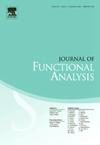One-bubble nodal blow-up for asymptotically critical stationary Schrödinger-type equations
IF 1.7
2区 数学
Q1 MATHEMATICS
引用次数: 0
Abstract
We investigate in this work families of sign-changing blowing-up solutions of asymptotically critical stationary nonlinear Schrödinger equations of the following type: in a closed Riemannian manifold , where converges to h in and as . Assuming that blows-up as a single sign-changing bubble, we obtain necessary conditions for blow-up that constrain the localisation of blow-up points and exhibit a strong interaction between h, the geometry of and the bubble itself. These conditions are new and are a consequence of the sign-changing nature of .
求助全文
约1分钟内获得全文
求助全文
来源期刊
CiteScore
3.20
自引率
5.90%
发文量
271
审稿时长
7.5 months
期刊介绍:
The Journal of Functional Analysis presents original research papers in all scientific disciplines in which modern functional analysis plays a basic role. Articles by scientists in a variety of interdisciplinary areas are published.
Research Areas Include:
• Significant applications of functional analysis, including those to other areas of mathematics
• New developments in functional analysis
• Contributions to important problems in and challenges to functional analysis

 求助内容:
求助内容: 应助结果提醒方式:
应助结果提醒方式:


